Composting as Manure Disposal Strategy in Small/Medium-Size Livestock Farms: Some Demonstrations with Operative Indications
Abstract
1. Introduction
2. Materials and Methods
2.1. The Study Context
- The private farm “Iasi Agrizoo”, located in Forenza (Basilicata, Italy, 40°51′37″ N, 15°51′16″ E);
- “Coop. Agrocarne Sud”, a cooperative company that takes care of the breeding, slaughtering, and processing of pig meat nearby Latronico, a village in Potenza province (Basilicata, Italy, 40°05′20″ N, 16°00′34″ E);
- “Nardozza and Rosa”, a private cereal-livestock farm, located in Maschito (Basilicata, Italy, 40°54′32″ N, 15°49′46″ E);
- “Santoro” farm, a private cereal-livestock runs directly by the owner, located within Potenza province (Bella, Basilicata, Italy, 40°43′29.8″N, 15°35′53.4″E).
2.2. Criteria for Choosing the Most Appropriate Composting Option within Demonstration Farms
3. Results and Discussion
3.1. Preliminary Survey Results and Operative Choices
- Training system: Intensive;
- Average productions of dejections—as it is—per week: 7020 m3;
- Average production of “cruschello” per week: 130 m3 (40 tons);
- Average production of solid separated per week: 364 m3 (234 tons);
- Surface of the ex-drying beds: 1200 m2;
- Availability of mechanical means (third, shovel, manure spreader, etc.): Tractor with loader.
3.2. Composting Versus Conventional Manure Treatment Methods: A Further Study on “Santoro” Farm
3.3. Dissemination activities
4. Conclusions
Author Contributions
Funding
Acknowledgments
Conflicts of Interest
References and Note
- Strijker, D. Marginal lands in Europe—Causes of decline. Basic Appl. Ecol. 2005, 6, 99–106. [Google Scholar] [CrossRef]
- Thornton, P. Livestock production: Recent trends, future prospects. Philos. Trans. R. Soc. B Boil. Sci. 2010, 365, 2853–2867. [Google Scholar] [CrossRef] [PubMed]
- EC. EU Agricultural Outlook for Markets and Income, 2019–2030; European Commission, DG Agriculture and Rural Development: Brussels, Belgium, 2019. [Google Scholar]
- Eurostat. Agri-Environmental Indicator—Livestock Patterns. Available online: https://ec.europa.eu/eurostat/statistics-explained/index.php/Agri-environmental_indicator_-_livestock_patterns#Livestock_density_at_EU_level_in_2016 (accessed on 3 December 2019).
- ISTAT. VI Censimento Generale dell’Agricoltura; Istituto Nazionale di Statistica: Roma, Italy, 2010. [Google Scholar]
- Foged, H.L.; Flotats, X.; Bonmati Blasi, A.; Palatsi, J.; Magri, A.; Schelde, K.M. Inventory of Manure Processing Activities in Europe; Technical Report No. I to the European Commission, Directorate-General Environment concerning “Manure Processing Activities in Europe”; Project reference: ENV.B.1/ETU/2010/0007; Agro Business Park: Tjele, Denmark, 2012; 138p. [Google Scholar]
- European Commission. Collection and Analysis of Data for the Control of Emissions from the Spreading of Manure. 2014. Available online: https://ec.europa.eu/environment/air/pdf/Final%20Report.pdf (accessed on 15 February 2020).
- Yang, X.; Liu, E.; Zhu, X.; Wang, H.; Liu, H.; Liu, X.; Dong, W. Impact of Composting Methods on Nitrogen Retention and Losses during Dairy Manure Composting. Int. J. Environ. Res. Public Health 2019, 16, 3324. [Google Scholar] [CrossRef] [PubMed]
- Martinez, J.; Dabert, P.; Barrington, S.; Burton, C. Livestock waste treatment systems for environmental quality, food safety, and sustainability. Bioresour. Technol. 2009, 100, 5527–5536. [Google Scholar] [CrossRef] [PubMed]
- EU Commission. Directive 91/676/EEC. Council Directive of 12 December 1991 concerning the protection of waters against pollution caused by nitrates from agricultural sources. Off. J. Eur. Community 1991, L375, 1–8. [Google Scholar]
- Flotats, X.; Foged, H.L.; Bonmati Blasi, A.; Palatsi, J.; Magri, A.; Schelde, K.M. Manure Processing Technologies; Technical Report No. II to the European Commission, Directorate-General Environment concerning “Manure Processing Activities in Europe”; Project reference: ENV.B.1/ETU/2010/0007; Agro Business Park: Tjele, Denmark, 2011; 184p. [Google Scholar]
- Brodie, H.L.; Carr, L.E.; Condon, P. A Comparison of Static Pile and Turned Windrow Methods for Poultry Litter Compost Production. Compos. Sci. Util. 2000, 8, 178–189. [Google Scholar] [CrossRef]
- Breitenbeck, G.A.; Schellinger, D. Calculating the Reduction in Material Mass And Volume during Composting. Compos. Sci. Util. 2004, 12, 365–371. [Google Scholar] [CrossRef]
- Rynk, R.; van de Kamp, M.; Willson, G.B.; Singley, M.E.; Richard, T.L.; Kolega, J.J.; Gouin, F.R.; Laliberty, L., Jr.; Kay, D.; Murphy, D.W.; et al. On-Farm Composting Handbook; Northeast Regional 610 Agricultural Engineering Service: Ithaca, NY, USA, 1992; p. 186. [Google Scholar]
- Pergola, M.; Persiani, A.; Pastore, V.; Palese, A.M.; D’Adamo, C.; De Falco, E.; Celano, G. Sustainability Assessment of the Green Compost Production Chain from Agricultural Waste: A Case Study in Southern Italy. Agronomy 2020, 10, 230. [Google Scholar] [CrossRef]
- Gitarskiy, M.; Yu, A. Izrael Institute of Global Climate and Ecology the Refinement To The 2006 Ipcc Guidelines For National Greenhouse Gas Inventories. Fundam. Appl. Clim. 2019, 2. [Google Scholar] [CrossRef]
- Sánchez, A.; Artola, A.; Font, X.; Gea, T.; Barrena, R.; Gabriel, D.; Sanchez-Monedero, M.A.; Roig, A.; Cayuela, M.L.; Mondini, C. Greenhouse Gas from Organic Waste Composting: Emissions and Measurement. In CO2 Sequestration, Biofuels and Depollution; Lichtfouse, Z., Schwarzbauer, J., Robert, D., Eds.; Springer: Cham, Switzerland, 2015; Volume 5, pp. 33–70. [Google Scholar]
- Misra, R.V.; Roy, R.N.; Hiraoka, H. On-farm Composting Methods; Food and Agriculture Organization of the United Nations (FAO): Rome, Italy, 2003; pp. 1–35. [Google Scholar]
- ISO. International Standards Organisation, ISO 14044. Environmental Management—Life Cycle Assessment—Requirements and Guidelines. 2006. Available online: https://www.iso.org/standard/38498.html (accessed on 8 December 2019).
- ISO. International Standards Organisation, ISO 14040. Environmental Management—Life Cycle Assessment—Requirements and Guidelines. 2006. Available online: https://www.iso.org/standard/37456.html (accessed on 8 December 2019).
- Norhasmillah, A.H.; Puah, C.W.; Ibrahim, N.A.; Baharuddin, A.S.; Choo, Y.M. Lifecycle inventory of the commercial production of compost from oil palm biomass: A case study. Environ. Dev. Sustain. 2013, 15, 1663–1670. [Google Scholar] [CrossRef]
- Saer, A.; Lansing, S.; Davitt, N.H.; Graves, R.E. Life cycle assessment of a food waste composting system: Environmental impact hotspots. J. Clean. Prod. 2013, 52, 234–244. [Google Scholar] [CrossRef]
- Pergola, M.; Persiani, A.; Palese, A.M.; Di Meo, V.; Pastore, V.; D’Adamo, C.; Celano, G. Composting: The way for a sustainable agriculture. Appl. Soil Ecol. 2018, 123, 744–750. [Google Scholar] [CrossRef]
- Guinée, J.B.; Gorrée, M.; Heijungs, R.; Huppes, G.; Kleijn, R.; de Koning, A.; van Oers, L.; Wegener Sleeswijk, A.; Suh, S.; Udo de Haes, H.A.; et al. Handbook on life cycle assessment. Operational guide to the ISO standards. I: LCA in perspective. IIa: Guide. IIb: Operational annex. III: Scientific background; Kluwer Academic Publishers: Dordrecht, The Netherlands, 2002; 692p, ISBN 1-4020-0228-9. [Google Scholar]
- Monarca, D.; Biondi, P.; Panaro, V.N.; Colantoni, A.; Bartoli, S.; Cecchini, M. Analisi delle richieste di energia per la coltivazione delle colture ortive. In Proceeding of IX Convegno Naz. Dell’Associazione Italiana di Ingegneria Agraria Memoria, Ischia Porto (Naples), Italy, 12-16/09/2009; Doppiavoce Napoli: Naples, Italy, 2009; pp. 10–12. [Google Scholar]
- Page, G. An Environmentally E Based Systems Approach to Sustainability Analysis of Organic Fruit Production Systems in New Zealand. Ph.D. Thesis, Massey University, Palmerston North, New Zealand, 2009. [Google Scholar]
- Lovell, P.H.; Pimental, D.; Pimental, M. Food, Energy and Society. J. Appl. Ecol. 1982, 19, 308. [Google Scholar] [CrossRef]
- Volpi, R. Bilanci Energetici in Agricoltura; Laruffa Editore: Reggio Calabria, Italy, 1992. [Google Scholar]
- Ruggieri, L.; Cadena, E.; Martínez-Blanco, J.; Gasol, C.M.; Rieradevall, J.; Gabarrell, X.; Gea, T.; Sort, X.; Sánchez, A. Recovery of organic wastes in the Spanish wine industry. Technical, economic and environmental analyses of the composting process. J. Clean. Prod. 2009, 17, 830–838. [Google Scholar] [CrossRef]
- Mu, D.; Horowitz, N.; Casey, M.; Jones, K. Environmental and economic analysis of an in-vessel food waste composting system at Kean University in the U.S. Waste Manag. 2017, 59, 476–486. [Google Scholar] [CrossRef] [PubMed]
- Pergola, M.; D’Amico, M.; Celano, G.; Palese, A.M.; Scuderi, A.; Di Vita, G.; Pappalardo, G.; Inglese, P. Sustainability evaluation of Sicily’s lemon and orange production: An energy, economic and environmental analysis. J. Environ. Manag. 2013, 128, 674–682. [Google Scholar] [CrossRef] [PubMed]
- Pergola, M.; Persiani, A.; Pastore, V.; Palese, A.M.; Arous, A.; Celano, G. A comprehensive Life Cycle Assessment (LCA) of three apricot orchard systems located in Metapontino area (Southern Italy). J. Clean. Prod. 2017, 142, 4059–4071. [Google Scholar] [CrossRef]
- Scotti, R.; Pane, C.; Spaccini, R.; Palese, A.M.; Piccolo, A.; Celano, G.; Zaccardelli, M. On-farm compost: A useful tool to improve soil quality under intensive farming systems. Appl. Soil Ecol. 2016, 107, 13–23. [Google Scholar] [CrossRef]
- Pane, C.; Celano, G.; Piccolo, A.; Villecco, D.; Spaccini, R.; Palese, A.M.; Zaccardelli, M. Effects of on-farm composted tomato residues on soil biological activity and yields in a tomato cropping system. Chem. Boil. Technol. Agric. 2015, 2, 169. [Google Scholar] [CrossRef]
- Decreto Legislativo 29 Aprile 2010, n. 75. Riordino e Revisione della Disciplina in Materia di Fertilizzanti, a Norma Dell’articolo 13 Della Legge 7 Luglio 2009.
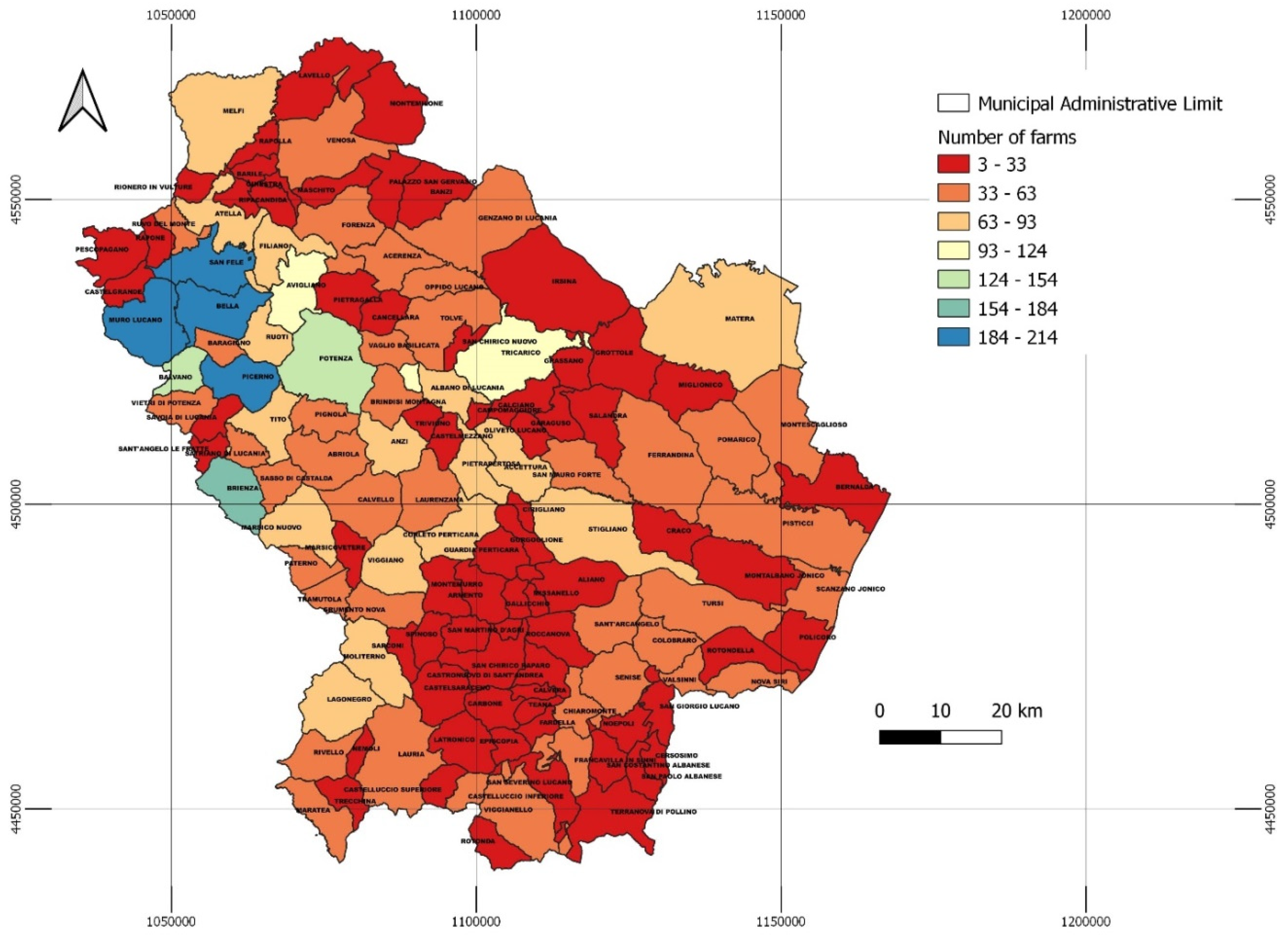
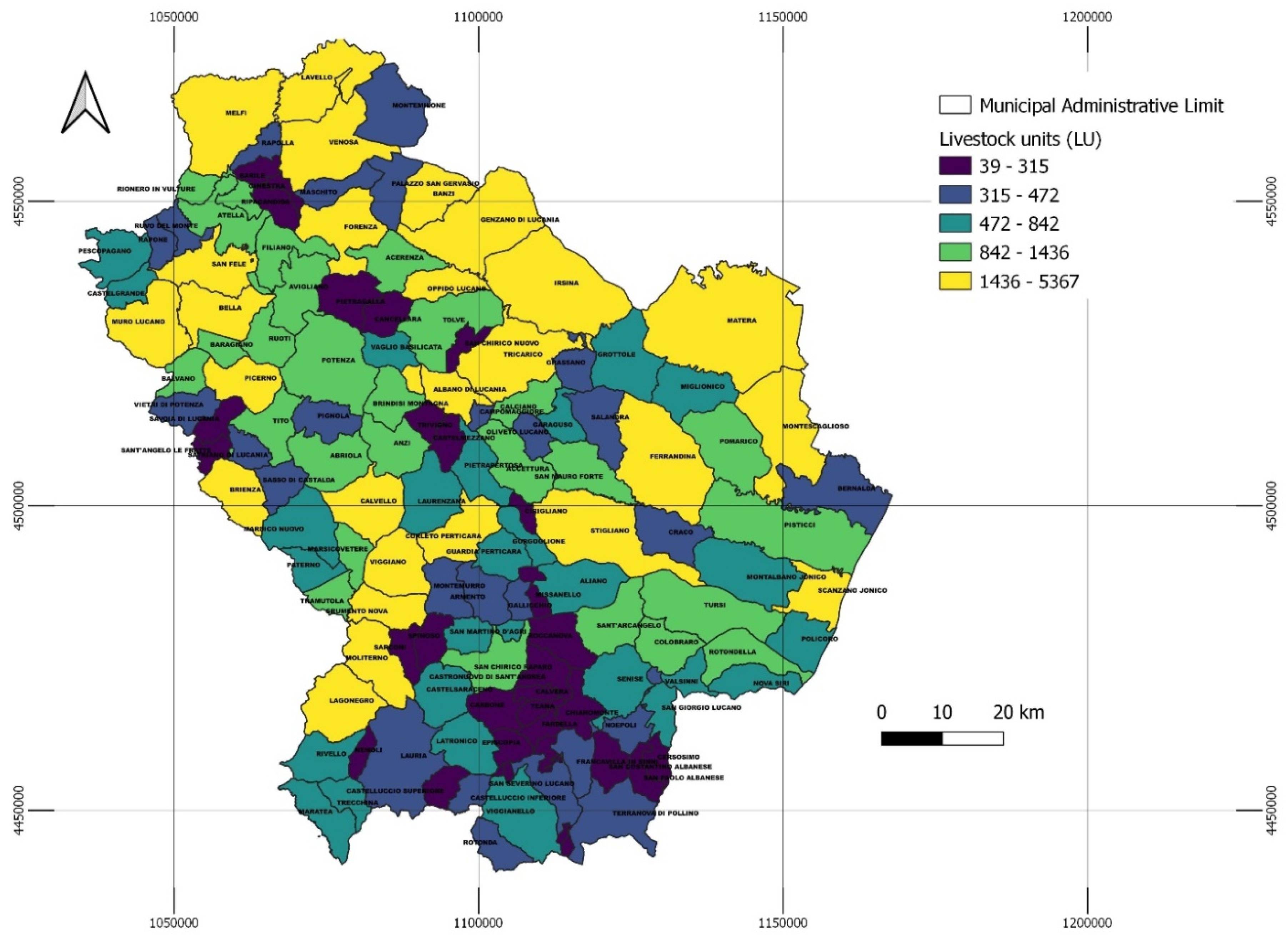
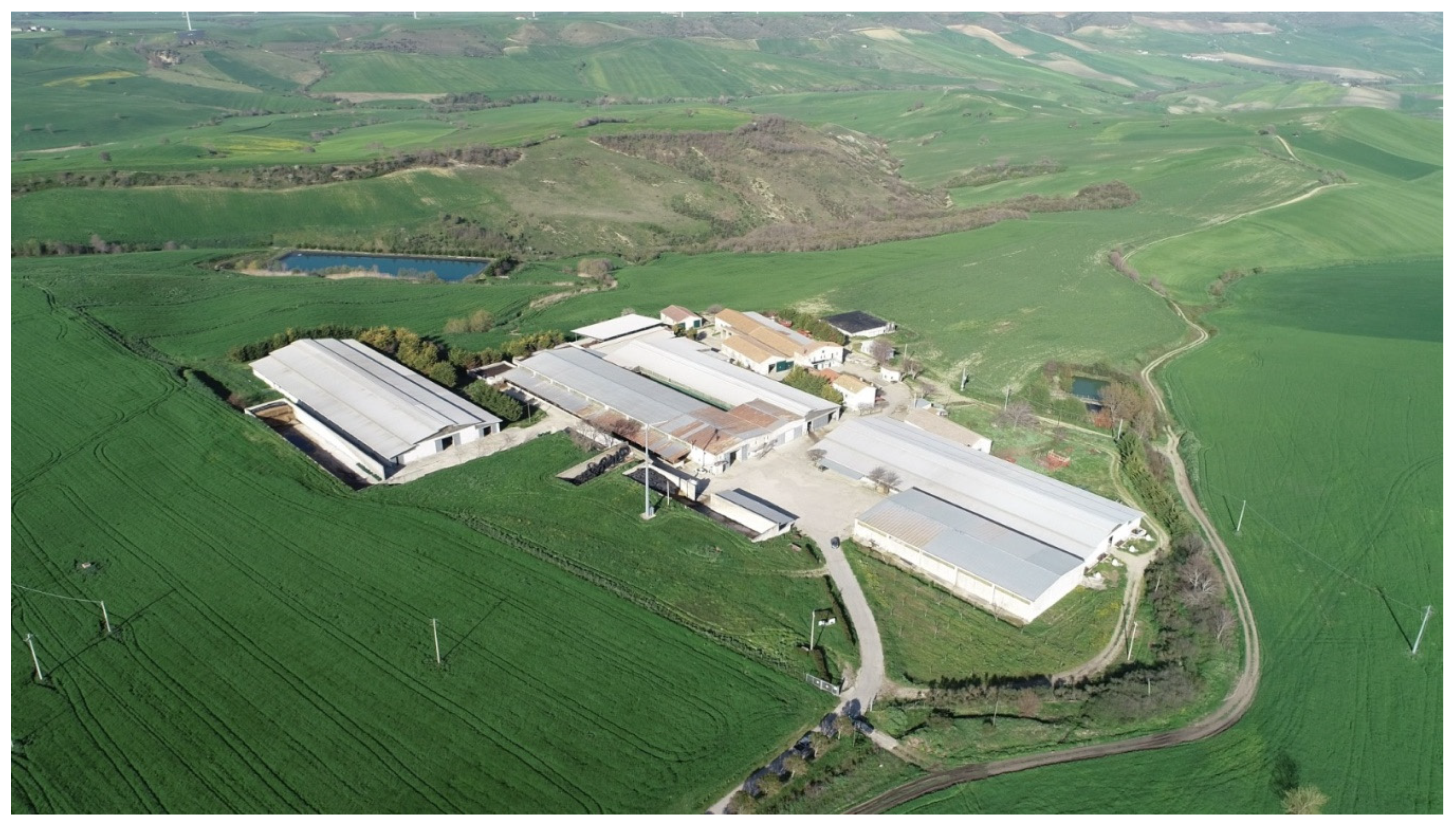
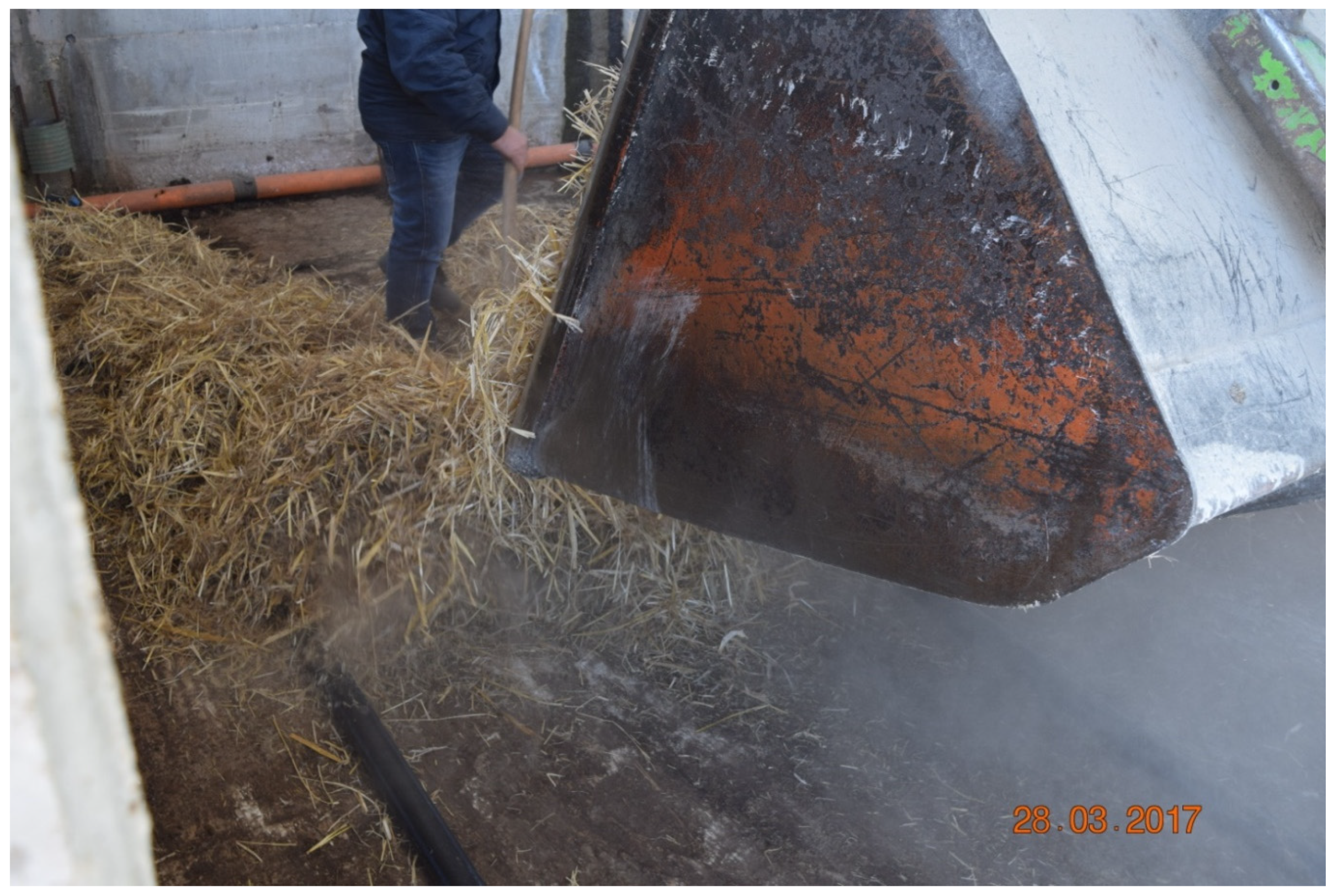
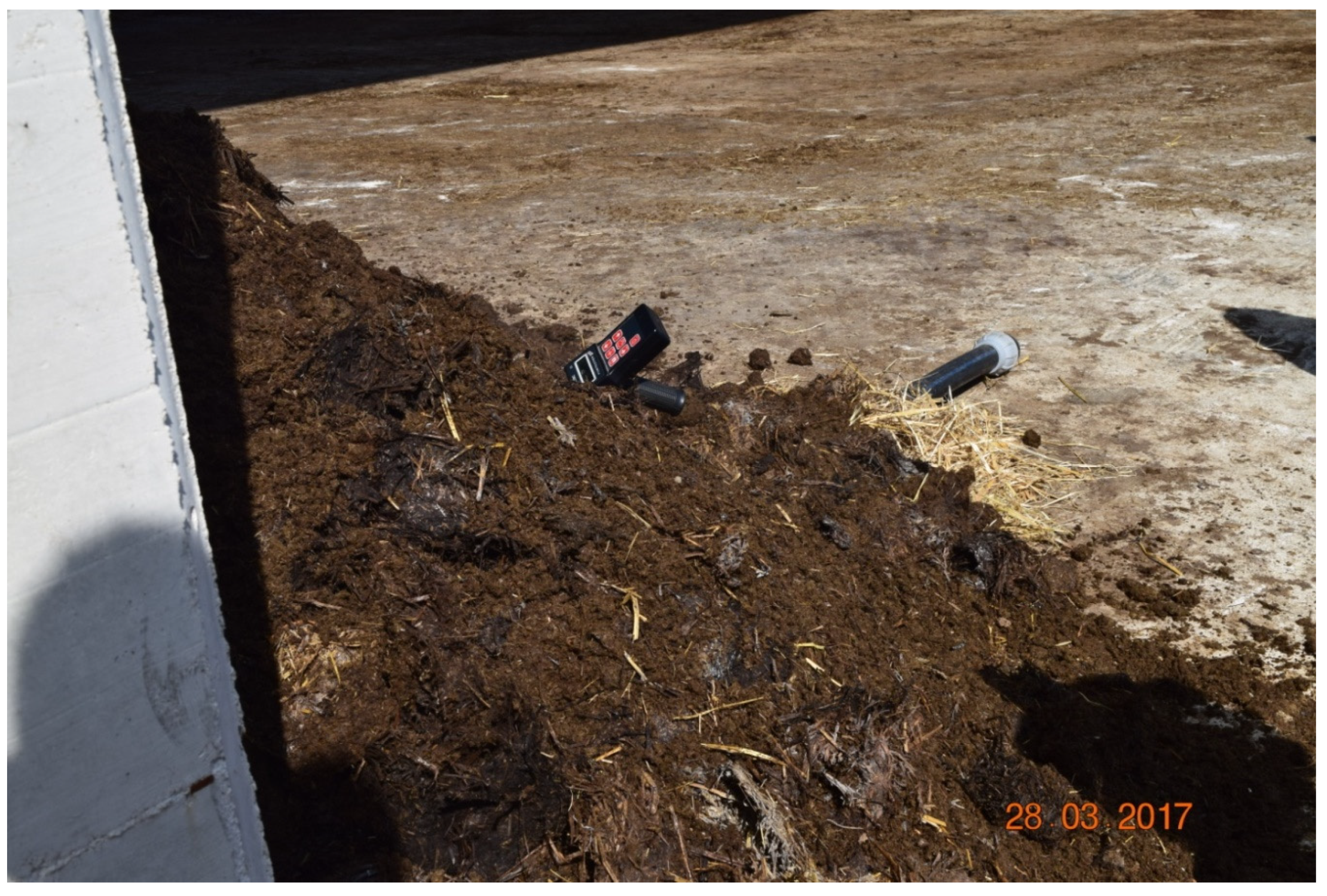
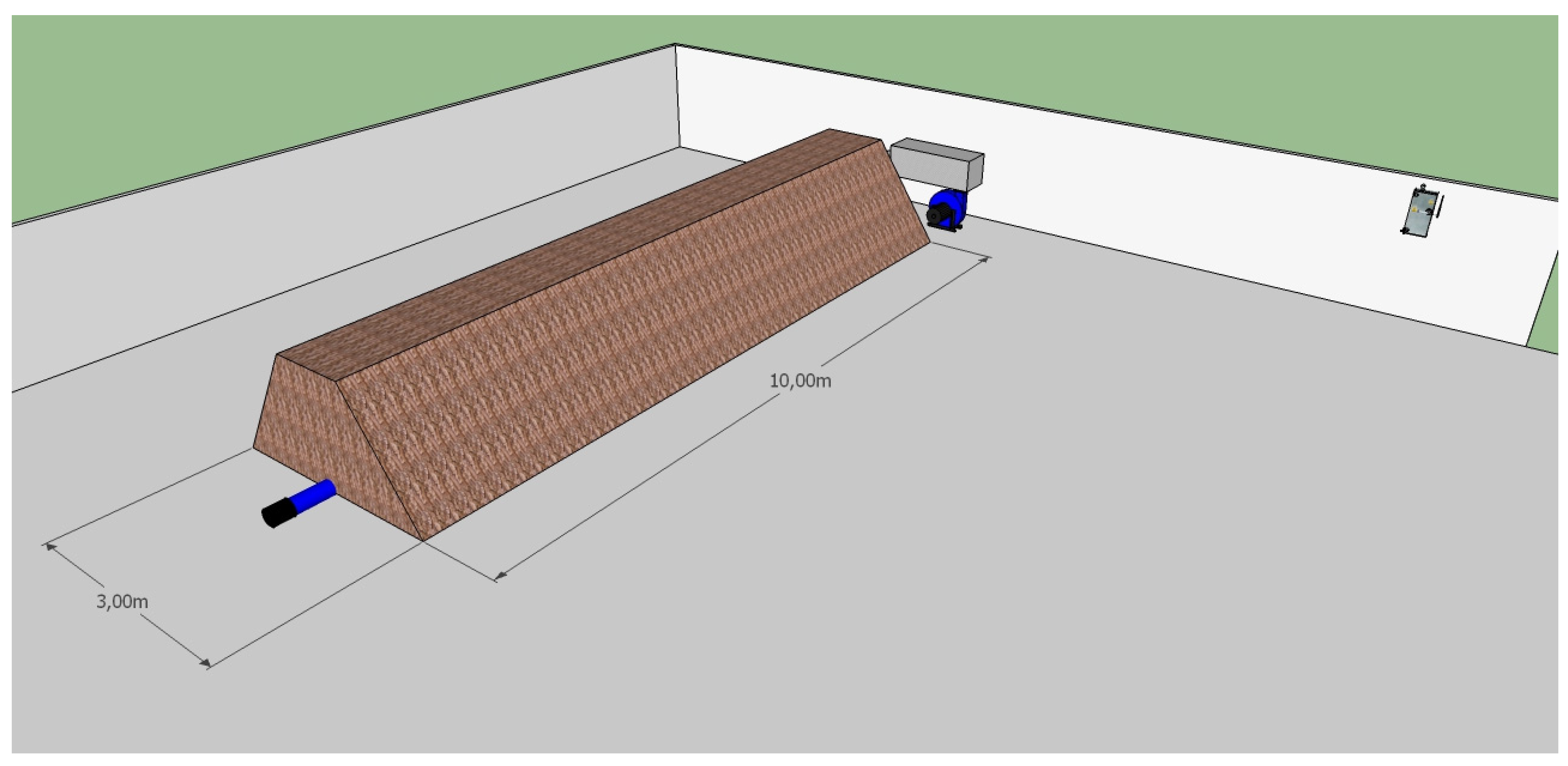
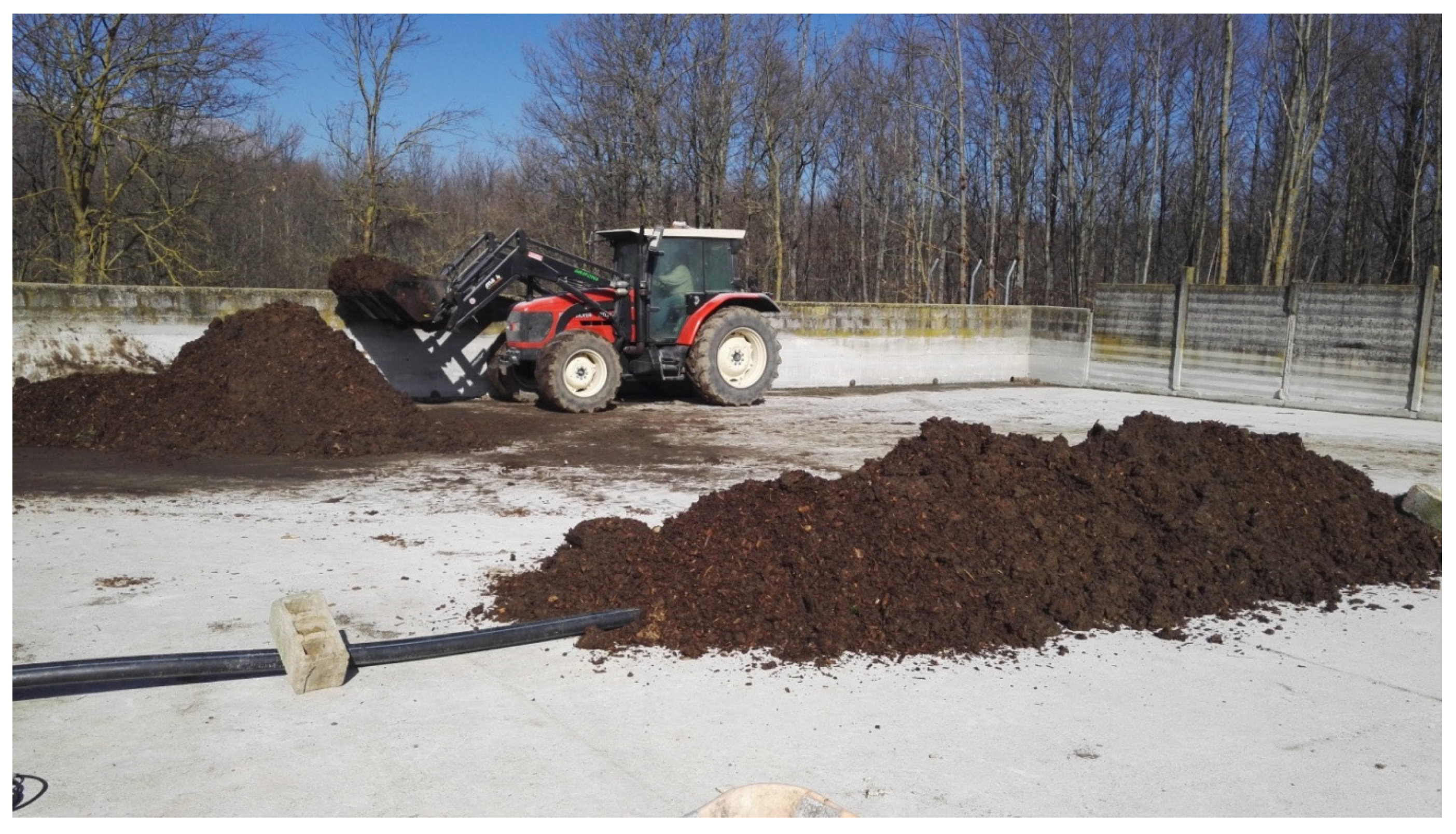
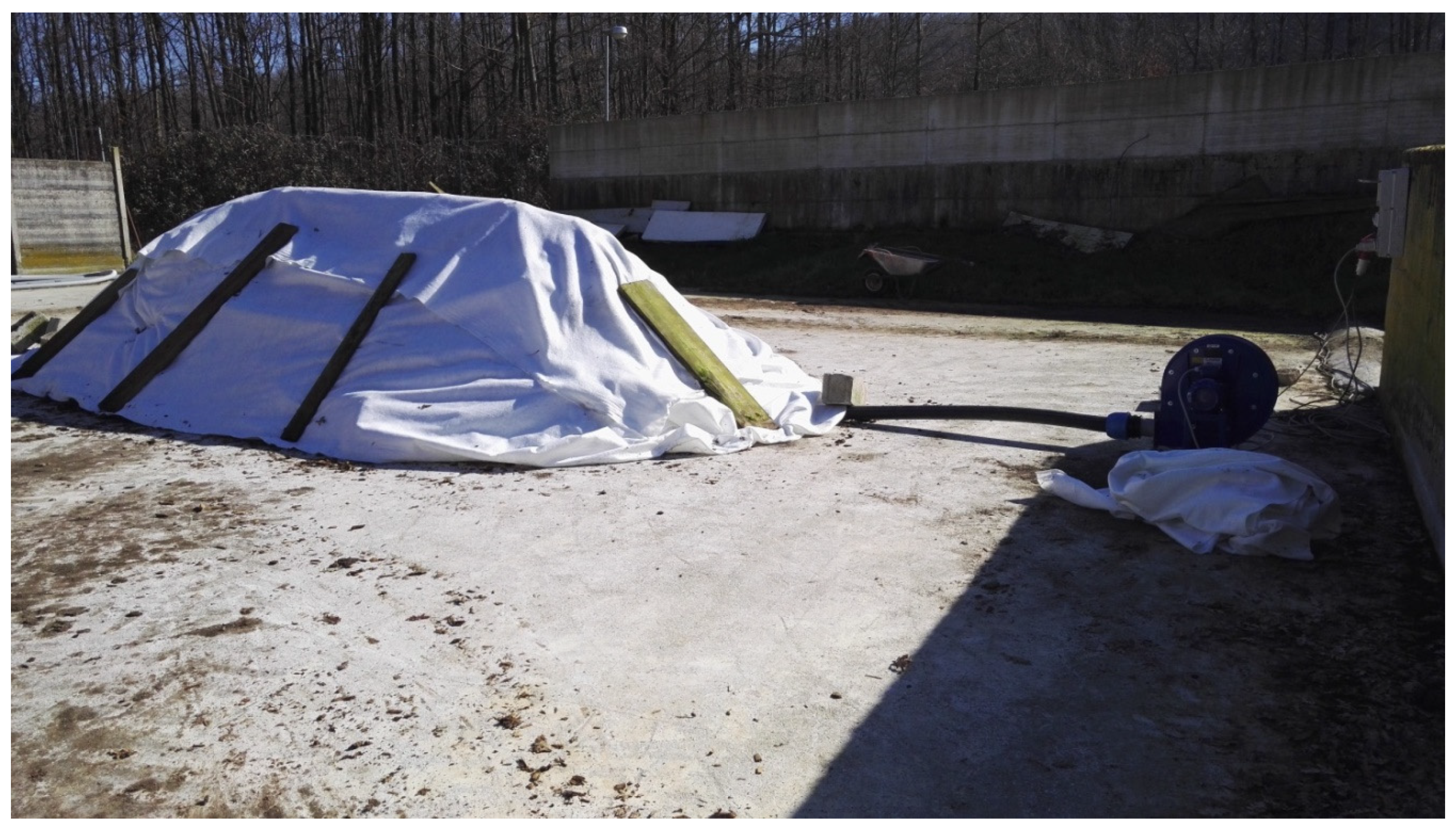
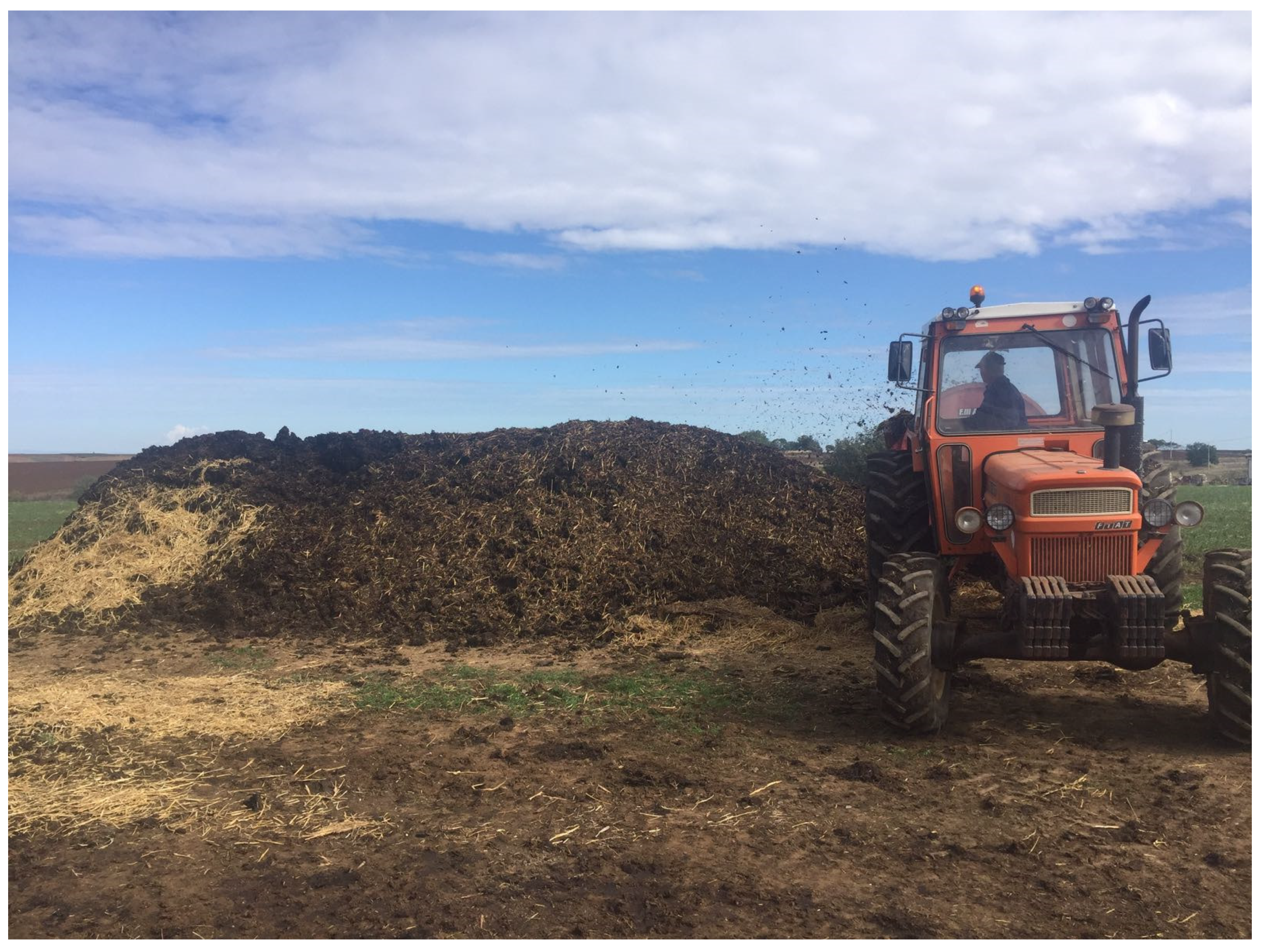
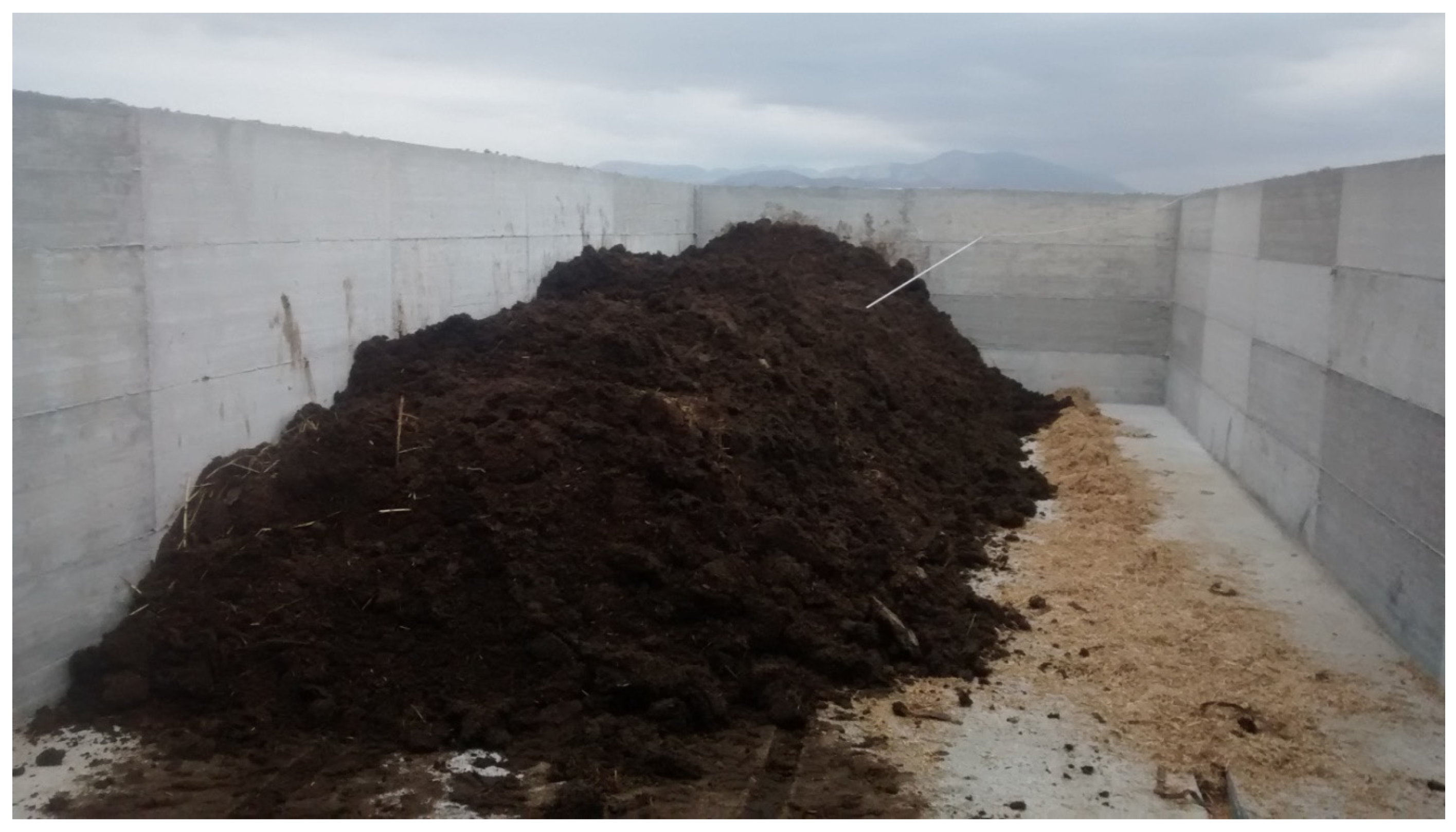
| LU Class | Farms Number | % |
|---|---|---|
| 1–9 | 3299 | 57% |
| 10–49 | 1919 | 33% |
| 50–99 | 338 | 6% |
| 100–499 | 172 | 3% |
| >500 | 17 | 0% |
| TOTAL | 5745 | 100% |
| Pre-Intervention Situation (Conventional) | |
|---|---|
| Value per Cycle | |
| Stall cleaning | |
| Machinery and farm tools (h) | 80 |
| Electricity (kWh) | 280 |
| Scraper cleaning | |
| Machinery and farm tools (h) | 10 |
| Human labour (h) | 10 |
| Water (l) | 6000 |
| Diesel oil (kg) | 0.5 |
| Manure homogenization | |
| Machinery and farm tools (h) | 3.4 |
| Human labor (h) | 1.7 |
| Diesel oil (kg) | 9 |
| Manure loading | |
| Machinery and farm tools (h) | 4 |
| Human labor (h) | 2 |
| Diesel oil (kg) | 9 |
| Transport and distribution of manure | |
| Machinery and farm tools (h) | 30 |
| Human labor (h) | 15 |
| Diesel oil (kg) | 79 |
| Post-Intervention Situation (after the Composting Plant Establishment) | ||
|---|---|---|
| Value per Cycle | Value per Ton | |
| Construction of the composting plant | ||
| Capital equipment (kg) | 507 | 9.39 |
| Wood chips transport | ||
| Machinery and farm tools (h) | 2 | 0.04 |
| Human labor (h) | 2.5 | 0.05 |
| Diesel oil (kg) | 32 | 0.59 |
| Wood chips distribution within the stall | ||
| Machinery and farm tools (h) | 1.5 | 0.03 |
| Human labor (h) | 3 | 0.06 |
| Diesel oil (kg) | 5 | 0.09 |
| Stall cleaning and pile preparation | ||
| Machinery and farm tools (h) | 2.5 | 0.05 |
| Human labor (h) | 4 | 0.07 |
| Diesel oil (kg) | 9 | 0.17 |
| Air insufflation and pile management | ||
| Machinery and farm tools (h) | 90 | 1.67 |
| Electricity (kWh) | 360 | 6.67 |
| Platform unloading | ||
| Machinery and farm tools (h) | 3 | 0.06 |
| Human labor (h) | 3 | 0.06 |
| Diesel oil (kg) | 11 | 0.20 |
| Loading for transport | ||
| Machinery and farm tools (h) | 0.83 | 0.02 |
| Human labor (h) | 0.83 | 0.02 |
| Diesel oil (kg) | 3 | 0.06 |
| Transport and distribution of compost | ||
| Machinery and farm tools (h) | 8.2 | 0.15 |
| Human labor (h) | 4 | 0.07 |
| Diesel oil (kg) | 22 | 0.41 |
| Iasi Agrizoo | Coop. Agrocarne Sud | Nardozza and Rosa | Santoro | |
|---|---|---|---|---|
| Farm location | Italy—Basilicata region- Forenza (PZ) 40°51′37″ N, 15°51′16″ E | Italy—Basilicata region- Latronico (PZ) 40°05′20″ N, 16°00′34″ E | Italy—Basilicata region- Maschito (PZ) 40°54′32″ N, 15°49′46″ E | Italy—Basilicata region- Bella (PZ) 40°43′29.8“N, 15°35′53.4‘‘E |
| Farm productions | dairy cattle | pork | dairy sheep and lamb | dairy cattle |
| Breeds bred | cattle (Friesian and Jersey) | pigs (suino nero Lucano) | sheep (Merino-derived) | cattle (Friesian) |
| Number of raised animals | 650 | 2000 | 600 | 49 |
| Main by-product to be used for composting | solid separate from cattle manure | solid separate from pigs’ slurry | sheep manure | cattle manure |
| By- product quantity | 2555 m3 year−1 | 364 m3 year−1 | 440 m3 year−1 | 708 m3 year−1 |
| Others raw materials | straw, unifeed waste, deteriorated forage | cruschello | straw | straw |
| Others raw materials quantity | variable (<250 m3 year−1) | 130 m3 year−1 | - | - |
| concrete platform for composting | YES | YES | NO | YES |
| Machinery for composting | mechanical shovel (bobcat) | tractor with a shovel | tractor with a shovel, manure spreader | mechanical shovel (bobcat) |
| Composting typology | aerated static pile | aerated static pile | static pile | aerated static pile |
| Capacity of the demonstration composting plant | 100 m3 year−1 | 72 m3 year−1 | 60 m3 year−1 | 1800 m3 year−1 |
| Operative Activity | MJ | kg (CO2eq) | Euro |
|---|---|---|---|
| Pre-intervention situation (conventional) | |||
| Stall cleaning | 3978 | 225 | 151 |
| Scraper cleaning | 26 | 2 | 65 |
| Manure homogenization | 532 | 44 | 36 |
| Manure loading | 508 | 42 | 56 |
| Transport and distribution of manure | 4572 | 382 | 500 |
| Total | 9616 | 695 | 808 |
| Post-intervention situation (after the composting plant establishment) | |||
| Construction of the composting plant | 3368 | 105 | 44 |
| Wood chips transport | 1629 | 170 | 300 |
| Wood chips distribution within the stall | 304 | 26 | 29 |
| Stall cleaning and pile preparation | 505 | 43 | 36 |
| Air insufflation and pile management | 2862 | 171 | 63 |
| Platform unloading | 137 | 8 | 36 |
| Loading for transport | 167 | 14 | 10 |
| Transport and distribution of compost | 1525 | 119 | 131 |
| Total | 10497 | 656 | 649 |
| Total for 1 ton of dry compost produced | 208 | 13 | 13 |
© 2020 by the authors. Licensee MDPI, Basel, Switzerland. This article is an open access article distributed under the terms and conditions of the Creative Commons Attribution (CC BY) license (http://creativecommons.org/licenses/by/4.0/).
Share and Cite
Palese, A.M.; Persiani, A.; D’Adamo, C.; Pergola, M.; Pastore, V.; Sileo, R.; Ippolito, G.; Lombardi, M.A.; Celano, G. Composting as Manure Disposal Strategy in Small/Medium-Size Livestock Farms: Some Demonstrations with Operative Indications. Sustainability 2020, 12, 3315. https://doi.org/10.3390/su12083315
Palese AM, Persiani A, D’Adamo C, Pergola M, Pastore V, Sileo R, Ippolito G, Lombardi MA, Celano G. Composting as Manure Disposal Strategy in Small/Medium-Size Livestock Farms: Some Demonstrations with Operative Indications. Sustainability. 2020; 12(8):3315. https://doi.org/10.3390/su12083315
Chicago/Turabian StylePalese, Assunta Maria, Alessandro Persiani, Carmine D’Adamo, Maria Pergola, Vittoria Pastore, Rocco Sileo, Giuseppe Ippolito, Maria Assunta Lombardi, and Giuseppe Celano. 2020. "Composting as Manure Disposal Strategy in Small/Medium-Size Livestock Farms: Some Demonstrations with Operative Indications" Sustainability 12, no. 8: 3315. https://doi.org/10.3390/su12083315
APA StylePalese, A. M., Persiani, A., D’Adamo, C., Pergola, M., Pastore, V., Sileo, R., Ippolito, G., Lombardi, M. A., & Celano, G. (2020). Composting as Manure Disposal Strategy in Small/Medium-Size Livestock Farms: Some Demonstrations with Operative Indications. Sustainability, 12(8), 3315. https://doi.org/10.3390/su12083315







